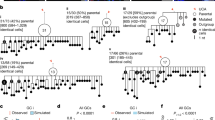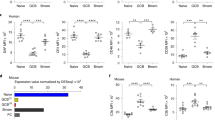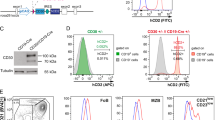Abstract
Germinal centers (GC) of secondary lymphoid tissues are critical to mounting a high-affinity humoral immune response. B cells within the GC undergo rapid clonal expansion and selection while diversifying their antibody genes. Although it is generally believed that GC B cells employ a unique proliferative program to accommodate these processes, little is known about how the GC-associated cell cycle is orchestrated. The D-type cyclins constitute an important component of the cell cycle engine that enables the cells to respond to physiological changes. Cell type- and developmental stage-specific roles of D-type cyclins have been described but the cyclin D requirement during GC reaction has not been addressed. In this study, we report that cyclin D3 is largely dispensable for proliferation and Ig class switching of in vitro activated B cells. In contrast, GC development in Ccnd3−/− mice is markedly impaired, as is the T cell-dependent antibody response. Within the GC, although both switched and unswitched B cells are affected by cyclin D3 inactivation, the IgM− pool is more severely reduced. Interestingly, despite a compensatory increase in cyclin D2 expression, a significant number of Ccnd3−/− GC B cells accumulate in quiescent G0 state. Lastly, although cyclin D3 inactivation did not disrupt BCL6 expression in GC B cells, it completely blocked the GC promoting effect of BCL6 overexpression, suggesting that cyclin D3 acts downstream of BCL6 to regulate GC formation. This is the first demonstration that cyclin D3 plays an important and unique role at the GC stage of B cell development.
Similar content being viewed by others
Log in or create a free account to read this content
Gain free access to this article, as well as selected content from this journal and more on nature.com
or
Abbreviations
- CSR:
-
(class switch recombination)
- Cdk:
-
(cyclin dependent kinase)
- DAPI:
-
(diamidino-2-phenylindole)
- DLBCL:
-
(diffuse large B cell lymphoma)
- DN:
-
(double negative)
- FDC:
-
(follicular dendritic cell)
- Fo:
-
(follicular B cells)
- GC:
-
(germinal center)
- IHC:
-
(immunohistochemistry)
- KO:
-
(knock-out)
- LN:
-
(lymph node)
- MZ:
-
(marginal zone)
- NP:
-
(nitrophenyl)
- PNA:
-
(peanut agglutinin)
- PI:
-
(propidium iodide)
- SHM:
-
(somatic hypermutation)
- Tfh:
-
(T follicular helper cells)
References
Stavnezer J, Guikema JE, Schrader CE . Mechanism and regulation of class switch recombination. Annu Rev Immunol 2008; 26:261–292.
Peled JU, Kuang FL, Iglesias-Ussel MD, et al. The biochemistry of somatic hypermutation. Annu Rev Immunol 2008; 26:481–511.
Wang Y, Carter RH . CD19 regulates B cell maturation, proliferation, and positive selection in the FDC zone of murine splenic germinal centers. Immunity 2005; 22:749–761.
Allen CD, Okada T, Cyster JG . Germinal-center organization and cellular dynamics. Immunity 2007; 27:190–202.
Klein U, Dalla-Favera R . Germinal centres: role in B-cell physiology and malignancy. Nat Rev Immunol 2008; 8:22–33.
Shaffer AL, Rosenwald A, Hurt EM, et al. Signatures of the immune response. Immunity 2001; 15:375–385.
Ci W, Polo JM, Cerchietti L, et al. The BCL6 transcriptional program features repression of multiple oncogenes in primary B-cells and is deregulated in DLBCL. Blood 2009; 113:5536–5548.
Yu RY, Wang X, Pixley FJ, et al. BCL-6 negatively regulates macrophage proliferation by suppressing autocrine IL-6 production. Blood 2005; 105:1777–1784.
Tourigny MR, Ursini-Siegel J, Lee H, et al. CDK inhibitor p18 (INK4c) is required for the generation of functional plasma cells. Immunity 2002; 17:179–189.
Massague J . G1 cell-cycle control and cancer. Nature 2004; 432:298–306.
Sherr CJ, Roberts JM . CDK inhibitors: positive and negative regulators of G1-phase progression. Genes Dev 1999; 13:1501–1512.
Kozar K, Ciemerych MA, Rebel VI, et al. Mouse development and cell proliferation in the absence of D-Cyclins. Cell 2004; 118:477–491.
Sicinska E, Aifantis I, Le Cam L, et al. Requirement for cyclin D3 in lymphocyte development and T cell leukemias. Cancer Cell 2003; 4:451–461.
Cooper AB, Sawai CM, Sicinska E, et al. A unique function for cyclin D3 in early B cell development. Nat Immunol 2006; 7:489–497.
Sonoki T, Harder L, Horsman DE, et al. Cyclin D3 is a target gene of t(6;14)(p21.1;q32.3) of mature B-cell malignancies. Blood 2001; 98:2837–2844.
Filipits M, Jaeger U, Pohl G, et al. Cyclin D3 is a predictive and prognostic factor in diffuse large B-cell lymphoma. Clin Cancer Res 2002; 8:729–733.
Hogerkorp CM, Borrebaeck CA . The human CD77- B cell population represents a heterogeneous subset of cells comprising centroblasts, centrocytes, and plasmablasts, prompting phenotypical revision. J Immunol 2006; 177:4341–4349.
Doglioni C, Chiarelli C, Macri E, et al. Cyclin D3 expression in normal, reactive and neoplastic tissues. J Pathol 1998; 185:159–166.
Teramoto N, Pokrovskaja K, Szekely L, et al. Expression of cyclin D2 and D3 in lymphoid lesions. Int J Cancer 1999; 81:543–550.
Shaffer AL, Yu X, He Y, et al. BCL-6 represses genes that function in lymphocyte differentiation, inflammation, and cell cycle control. Immunity 2000; 13:199–212.
Mataraza JM, Tumang JR, Gumina MR, et al. Disruption of cyclin D3 blocks proliferation of normal B-1a cells, but loss of cyclin D3 is compensated by cyclin D2 in cyclin D3-deficient mice. J Immunol 2006; 177:787–795.
Wen L, Brill-Dashoff J, Shinton SA, et al. Evidence of marginal-zone B cell-positive selection in spleen. Immunity 2005; 23:297–308.
Casola S, Otipoby KL, Alimzhanov M, et al. B cell receptor signal strength determines B cell fate. Nat Immunol 2004; 5:317–327.
Takahashi Y, Dutta PR, Cerasoli DM, Kelsoe G . In situ studies of the primary immune response to (4-Hydroxy-3-Nitrophenyl)Acetyl. V. affinity maturation develops in two stages of clonal selection. J Exp Med 1998; 187:885–895.
Wang Y, Brooks SR, Li X, et al. The physiologic role of CD19 cytoplasmic tyrosines. Immunity 2002; 17:501–514.
Lam EWF, Glassford J, Banerji L, et al. Cyclin D3 compensates for loss of cyclin D2 in mouse B-lymphocytes activated via the antigen receptor and CD40. J Biol Chem 2000; 275:3479–3484.
Ye BH, Cattoretti G, Shen Q, et al. The BCL-6 proto-oncogene controls germinal-centre formation and Th2- type inflammation. Nat Genet 1997; 16:161–170.
Dent AL, Shaffer AL, Yu X, Allman D, Staudt LM . Control of inflammation, cytokine expression, and germinal center formation by BCL-6. Science 1997; 276:589–592.
Cattoretti G, Chang CC, Cechova K, et al. BCL-6 protein is expressed in germinal-center B cells. Blood 1995; 86:45–53.
Kuppers R, Klein U, Schwering I, et al. Identification of Hodgkin and Reed-Sternberg cell-specific genes by gene expression profiling. J Clin Invest 2003; 111:529–537.
Cattoretti G, Pasqualucci L, Ballon G, et al. Deregulated BCL6 expression recapitulates the pathogenesis of human diffuse large B cell lymphomas in mice. Cancer Cell 2005; 7:445–455.
Lam EW, Glassford J, Banerji L, et al. Cyclin D3 compensates for loss of cyclin D2 in mouse B-lymphocytes activated via the antigen receptor and CD40. J Biol Chem 2000; 275:3479–3484.
Luckey CJ, Bhattacharya D, Goldrath AW, et al. Memory T and memory B cells share a transcriptional program of self-renewal with long-term hematopoietic stem cells. Proc Natl Acad Sci USA 2006; 103:3304–3309.
Tangye SG, Hodgkin PD . Divide and conquer: the importance of cell division in regulating B-cell responses. Immunology 2004; 112:509–520.
Toellner KM, Gulbranson-Judge A, Taylor DR, Sze DM, MacLennan IC . Immunoglobulin switch transcript production in vivo related to the site and time of antigen-specific B cell activation. J Exp Med 1996; 183:2303–2312.
Benson MJ, Elgueta R, Schpero W, et al. Distinction of the memory B cell response to cognate antigen versus bystander inflammatory signals. J Exp Med 2009; 206:2013–2025.
Satyanarayana A, Kaldis P . Mammalian cell-cycle regulation: several Cdks, numerous cyclins and diverse compensatory mechanisms. Oncogene 2009; 28:2925–2939.
Kozar K, Sicinski P . Cell cycle progression without cyclin D-CDK4 and cyclin D-CDK6 complexes. Cell Cycle 2005; 4:388–391.
Mullany LK, White P, Hanse EA,et al. Distinct proliferative and transcriptional effects of the D-type cyclins in vivo. Cell Cycle 2008; 7:2215–2224.
Lamb J, Ramaswamy S, Ford HL, et al. A mechanism of cyclin D1 action encoded in the patterns of gene expression in human cancer. Cell 2003; 114:323–334.
Peterson LF, Boyapati A, Ranganathan V,et al. The hematopoietic transcription factor AML1 (RUNX1) is negatively regulated by the cell cycle protein cyclin D3. Mol Cell Biol 2005; 25:10205–10219.
Olshavsky NA, Groh EM, Comstock CE, et al. Cyclin D3 action in androgen receptor regulation and prostate cancer. Oncogene 2008; 27:3111–3121.
Johnston RJ, Poholek AC, Ditoro D,et al. Bcl6 and Blimp-1 are reciprocal and antagonistic regulators of T follicular helper cell differentiation. Science 2009; 325:1006–1010.
Nurieva RI, Chung Y, Martinez GJ, et al. Bcl6 mediates the development of T follicular helper cells. Science 2009; 325:1001–1005.
Yu D, Rao S, Tsai LM, et al. The Transcriptional repressor Bcl-6 directs T follicular helper cell lineage commitment. Immunity 2009; 31:457–468.
Meyer-Bahlburg A, Khim S, Rawlings DJ . B cell intrinsic TLR signals amplify but are not required for humoral immunity. J Exp Med 2007; 204:3095–3101.
Mandal M, Powers SE, Ochiai K, et al. Ras orchestrates exit from the cell cycle and light-chain recombination during early B cell development. Nat Immunol 2009; 10:1110–1117.
Cattoretti G, Shaknovich R, Smith PM, et al. Stages of germinal center transit are defined by B cell transcription factor coexpression and relative abundance. J Immunol 2006; 177:6930–6939.
Bardwell PD, Woo CJ, Wei K, et al. Altered somatic hypermutation and reduced class-switch recombination in exonuclease 1-mutant mice. Nat Immunol 2004; 5:224–229.
Mendez LM, Polo JM, Yu JJ, et al. CtBP is an essential corepressor for BCL6 autoregulation. Mol Cell Biol 2008; 28:2175–2186.
Acknowledgements
We thank Dr Riccardo Dalla-Favera (Columbia University, USA) for sharing the Iμ-HA-BCL6 mouse strain, Drs Ulf Klein (Columbia University, USA) and Liang Zhu (Albert Einstein College of Medicine (AECOM), USA) for insightful suggestions, Dr Mimi Kim (AECOM) for expert statistical analysis, Drs Sergio Roa, Lydia Zhao and Susan Buhl (AECOM), and Lucas Tsikitas (Weill Cornell College of Medicine, USA) for their invaluable technical support. We are also indebted to Drs Arthur Skoultchi, Liang Zhu and Ganjam Kalpana (AECOM) for reagents. The AECOM Flow Cytometry Facility and Histopathology Facility are gratefully acknowledged. This work was supported by the Medical Scientist Training Program T32GM007288 (J.U.P.) and grants from the National Institutes of Health R01 CA85573 (B.H.Y), R01 CA72649 and CA102705 (M.D.S.), K08 CA127353 (R.S.), R01 AR049126 and AI051392 (B.D.), and P01 CA109901 (P.S). Support also came from the Harry Eagle Chair provided by the National Women's Division to M.D.S.
Author information
Authors and Affiliations
Corresponding author
Additional information
(Supplementary information is linked to the online version of the paper on the Cell Research website.)
Supplementary information
Figure S1
Histological validation of Cyclin D3 antibody and characterization of B cell splenic architecture in KO animals. (PDF 138 kb)
Figure S2
Schematic illustration of the immunization and bleeding schedule used to elicit T-cell dependent anti-NP response in Figure 4. (PDF 86 kb)
Figure S3
Class Switch Recombination to IgG1 is moderately impaired in the absence of cyclin D3. (PDF 26 kb)
Table S1
Antibodies used for IHC and Western Blot analyses. (PDF 52 kb)
Table S2
Sequences of qRT-PCR primers. (PDF 58 kb)
Rights and permissions
About this article
Cite this article
Peled, J., Yu, J., Venkatesh, J. et al. Requirement for cyclin D3 in germinal center formation and function. Cell Res 20, 631–646 (2010). https://doi.org/10.1038/cr.2010.55
Received:
Revised:
Accepted:
Published:
Issue date:
DOI: https://doi.org/10.1038/cr.2010.55
Keywords
This article is cited by
-
TLR7, a third signal for the robust generation of spontaneous germinal center B cells in systemic lupus erythematosus
Cellular & Molecular Immunology (2018)
-
Paradoxical role of Id proteins in regulating tumorigenic potential of lymphoid cells
Frontiers of Medicine (2018)
-
Activation of TLR7 increases CCND3 expression via the downregulation of miR-15b in B cells of systemic lupus erythematosus
Cellular & Molecular Immunology (2016)
-
Early B-cell-specific inactivation of ATM synergizes with ectopic CyclinD1 expression to promote pre-germinal center B-cell lymphomas in mice
Leukemia (2015)
-
Dynamics of B cells in germinal centres
Nature Reviews Immunology (2015)



